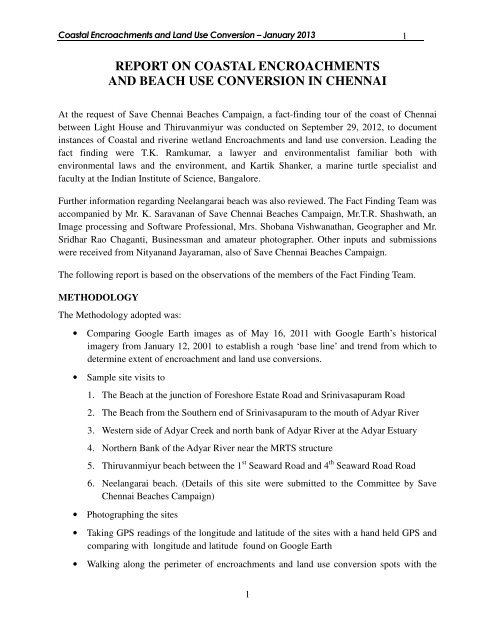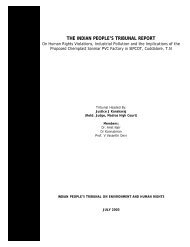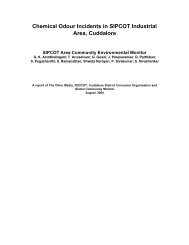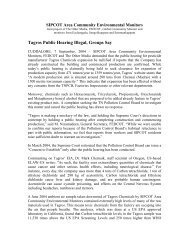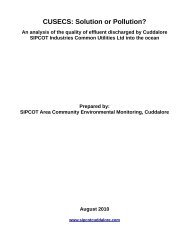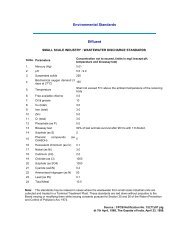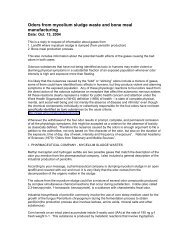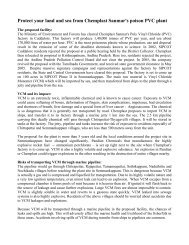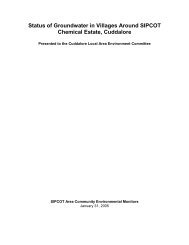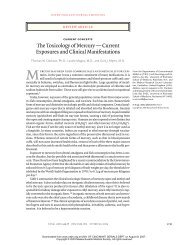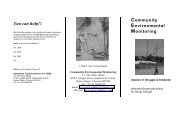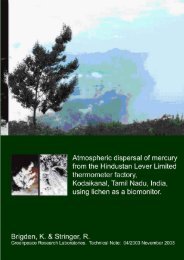Coastal Encroachment Fact Finding Report - SIPCOT Area ...
Coastal Encroachment Fact Finding Report - SIPCOT Area ...
Coastal Encroachment Fact Finding Report - SIPCOT Area ...
You also want an ePaper? Increase the reach of your titles
YUMPU automatically turns print PDFs into web optimized ePapers that Google loves.
<strong>Coastal</strong> <strong>Encroachment</strong>s and Land Use Conversion – January 2013<br />
1<br />
REPORT ON COASTAL ENCROACHMENTS<br />
AND BEACH USE CONVERSION IN CHENNAI<br />
At the request of Save Chennai Beaches Campaign, a fact-finding tour of the coast of Chennai<br />
between Light House and Thiruvanmiyur was conducted on September 29, 2012, to document<br />
instances of <strong>Coastal</strong> and riverine wetland <strong>Encroachment</strong>s and land use conversion. Leading the<br />
fact finding were T.K. Ramkumar, a lawyer and environmentalist familiar both with<br />
environmental laws and the environment, and Kartik Shanker, a marine turtle specialist and<br />
faculty at the Indian Institute of Science, Bangalore.<br />
Further information regarding Neelangarai beach was also reviewed. The <strong>Fact</strong> <strong>Finding</strong> Team was<br />
accompanied by Mr. K. Saravanan of Save Chennai Beaches Campaign, Mr.T.R. Shashwath, an<br />
Image processing and Software Professional, Mrs. Shobana Vishwanathan, Geographer and Mr.<br />
Sridhar Rao Chaganti, Businessman and amateur photographer. Other inputs and submissions<br />
were received from Nityanand Jayaraman, also of Save Chennai Beaches Campaign.<br />
The following report is based on the observations of the members of the <strong>Fact</strong> <strong>Finding</strong> Team.<br />
METHODOLOGY<br />
The Methodology adopted was:<br />
• Comparing Google Earth images as of May 16, 2011 with Google Earth’s historical<br />
imagery from January 12, 2001 to establish a rough ‘base line’ and trend from which to<br />
determine extent of encroachment and land use conversions.<br />
• Sample site visits to<br />
1. The Beach at the junction of Foreshore Estate Road and Srinivasapuram Road<br />
2. The Beach from the Southern end of Srinivasapuram to the mouth of Adyar River<br />
3. Western side of Adyar Creek and north bank of Adyar River at the Adyar Estuary<br />
4. Northern Bank of the Adyar River near the MRTS structure<br />
5. Thiruvanmiyur beach between the 1 st Seaward Road and 4 th Seaward Road Road<br />
6. Neelangarai beach. (Details of this site were submitted to the Committee by Save<br />
Chennai Beaches Campaign)<br />
• Photographing the sites<br />
• Taking GPS readings of the longitude and latitude of the sites with a hand held GPS and<br />
comparing with longitude and latitude found on Google Earth<br />
• Walking along the perimeter of encroachments and land use conversion spots with the<br />
1
<strong>Coastal</strong> <strong>Encroachment</strong>s and Land Use Conversion – January 2013<br />
2<br />
hand held GPS to calculate the area, using the area calculation option on the GPS<br />
• Physical observation of the six sites and interviewing local residents.<br />
• Incorporating information submitted regarding encroachments at other sites, including<br />
Neelangarai<br />
1. Foreshore Estate - Pattinapakkam<br />
[13 o 01’ 19.53” North; 80 o 16’41.92” East]<br />
As per the Google Earth image from 2001 to 2004 the stretch of beach from the junction of Srinivasapuram<br />
Road, Foreshore Estate Main Road and Foreshore Estate promenade to the sea was plain beach with beach<br />
sand.<br />
At the time of the site visit in September 2011, this portion was filled with construction debris to a<br />
height of about 2 meters, right upto the waterline. The debris had been compacted and made into a<br />
vehicle parking space. Enquires with the local fishermen revealed that each year, this beach was<br />
filled with debris to enable vehicles to drive up to the sea front and immerse idols post the Vinayaka<br />
Chaturthi Celebrations. Since our visit was conducted immediately after the Chaturthi celebrations,<br />
we witnessed piles of wood, plastic and other synthetic decorative waste washed up on the now<br />
constricted intertidal zone. Over the years, the filled-up site is being used for parking buses and other<br />
vehicles. The filled up portion of the beach as well as the surrounding stretches of sandy beach were<br />
littered with plastics. Dumping and compacting of debris right up to the waterfront has interfered<br />
with the South to North littoral drift and caused considerable erosion of the coastline just north of the<br />
land filled areas. [See Photo 1]<br />
The area of this raised and debris-filled portion was calculated by walking around the perimeter<br />
with the hand-held GPS. As per the GPS reading, the area was about 2.6 acres, with a possible<br />
error of about 4 meters. This was cross-checked with the track app ver 1.1.16 on a Samsung<br />
Galaxy Cell phone Model GT 155100 which revealed the same error margin. The dumping of<br />
debris and conversion of this area of the beach into a vehicle parking area is unauthorized and<br />
clearly in violation of the CRZ notification. Once a sandy beach, this area is now also being used<br />
as a venue for driving tests by the Regional Transport Office. This stretch of beach is now<br />
unsuitable as a nesting site for the highly endangered Olive Ridley Sea Turtle, and for fauna such<br />
as crustaceans and flora as well, usually found within the intertidal and near-tidal areas of the<br />
<strong>Coastal</strong> Regulation Zone.<br />
2
<strong>Coastal</strong> <strong>Encroachment</strong>s and Land Use Conversion – January 2013<br />
3<br />
1. Beach<br />
erosion at<br />
Pattinapakkam<br />
caused due to<br />
dumping of<br />
debris close to<br />
the waterline<br />
(Sept 2012).<br />
2. South of Srinivasapuram [13 o 00’56.96” North and 80 o 16’43.15” East]<br />
The second site visited was the stretch of beach south-east of Srinivasapuram abutting the Adyar<br />
Estuary. From a comparative study of the Google Earth historical imagery from 2001 to 2011, it<br />
can be seen that the coast at this point is very dynamic. The red-coloured line on the 2001 image<br />
indicates the width of the sandy beach. This had virtually disappeared in 2010, perhaps due to<br />
sea erosion. The 2011 image reveals a road running north to south. [See Photos 2, 3, 4] At the<br />
time of the visit, there was visible evidence of the road having been removed recently, with<br />
pieces of debris still mixed with the beach sand. The road had been removed, albeit improperly<br />
and unscientifically, pursuant to the interim order dated 7 August, 2012, of the National Green<br />
Tribunal in a case (Application No. 7/2012) filed by K. Saravanan. According to the local<br />
residents, construction debris was dumped by PWD contractors from the Srinivasapuram Beach<br />
Road to the water front to lay a road running North to South upto the mouth of the Adyar River<br />
to allow heavy vehicles to transport sand mined from the river and beach. The mining project<br />
was shelved after popular protests.<br />
Our visit also revealed that a significant portion of the beach from Srinivasapuram Beach Road<br />
to the waterline was filled and compacted with construction debris to a height of about 5 feet<br />
above the surrounding beach sand. This area now houses several tin sheds that have been rented<br />
out to migrant workers. The sheds lack even the most basic infrastructure such as running water<br />
and toilets, and their flimsy and makeshift nature render them unsuitable and hazardous for<br />
habitation so close to the sea. The area of the debris-compacted portion was about 0.4 acres.<br />
There was also evidence of removal of sand with the use of earth moving equipment. The whole<br />
area was littered with construction debris, plastics and other wastes.<br />
3
<strong>Coastal</strong> <strong>Encroachment</strong>s and Land Use Conversion – January 2013<br />
4<br />
In addition, a seawall that was constructed several years ago to arrest erosion has<br />
characteristically resulted in erosion north of the seawall as can be seen from the 2010 google<br />
earth image below. [See Photo 3]<br />
2. Google Earth image as on Jan 12, 2001<br />
3. As of 2010<br />
the pond has<br />
disappeared<br />
and significant<br />
sea erosion is<br />
noticeable in<br />
the northern<br />
half of the<br />
photograph.<br />
4
<strong>Coastal</strong> <strong>Encroachment</strong>s and Land Use Conversion – January 2013<br />
5<br />
4. 2011: A<br />
road has<br />
been laid<br />
running<br />
North to<br />
South,<br />
towards the<br />
river mouth.<br />
3. Western bank of Adyar Creek and Northern bank of Adyar River at the Adyar Estuary<br />
Site # 3 was the area West of and across the creek from Srinivasapuram, on the Western bank of<br />
the Adyar Creek. This tidal creek has experienced massive human intervention and land-use<br />
change over the past two decades. Till about 1997-98, the west bank of the Adyar Creek was<br />
partially a wetland and partially scrub, hosting a large variety of flora, and avian and terrestrial<br />
fauna. The features of the land started changing with the construction of a multi-storeyed<br />
building called Rani Meiyammai Towers on the southern end, near the Chettinadu palace. The<br />
Google Earth image from 2001 shows the southern portion as vacant land with scrub cover and<br />
the Northern portion as a wetland. The entire wetland portion has been reclaimed as can be seen<br />
from the Google earth image from 2011 and large multistoried constructions have come up on<br />
the reclaimed land [See Photo 5, 6].<br />
The road from MRC Nagar to the creek bund is now being used as an unauthorized dump site for<br />
construction and demolition debris by the Corporation of Chennai [See Photo 7]. Earlier<br />
dumping of debris along the creek has resulted in the construction of a 3 metre high bund. The<br />
natural banks of the creek have been destroyed and the bank now consists only of construction<br />
debris, and is compacted with blue metal and soil. During the site visit since the contour of the<br />
bank appeared to have changed, a comparison of the historical Google imagery was made with<br />
the most recent image of 2011 available. To facilitate comparison, red lines were drawn on the<br />
2011 image from the nearest building to the water edge. When this image was compared with the<br />
5
<strong>Coastal</strong> <strong>Encroachment</strong>s and Land Use Conversion – January 2013<br />
6<br />
2001 image it was found that the red marker lines extended beyond the banks. To measure the<br />
difference, yellow lines were drawn from the tip of the red lines to the water edge in the 2001<br />
image. It was found that the creek has been encroached to varying extents of about 1 meter at the<br />
first marker line in the North to about 8 meters at the last marker line in the south. It is estimated<br />
that the total area of the encroachment by the debris-filled bund on the creek is about 5.78 acres.<br />
All the high rise buildings were found to be releasing untreated sewage into the Adyar Creek<br />
through pipe lines.<br />
This portion of the Adyar creek harbored a large population of ‘Dhobi Crabs,’ bivalves and other<br />
crustaceans till about 2000, as well as a fair sprinkling of mangroves. These flora and fauna,<br />
characteristic of a healthy creek and estuarine ecosystem was missing at the time of the visit.<br />
The waterfront area in front of Chettinadu Palace too appeared to have been recently built by<br />
dumping construction debris on the creek. According to Save Chennai Beaches campaign, that<br />
area was reclaimed by dumping debris and red mud in 2010 [See Photo 8]. The newly-created<br />
land using debris was covered with earth, and planted with a lawn, with access to that area<br />
blocked off by a newly installed gate.<br />
6
ERROR: stackunderflow<br />
OFFENDING COMMAND: ~<br />
STACK:


